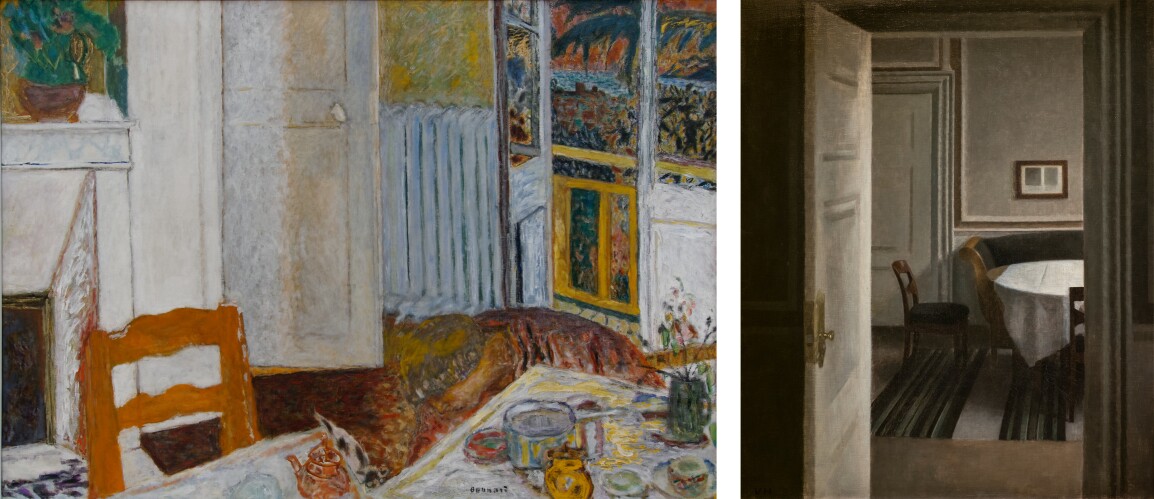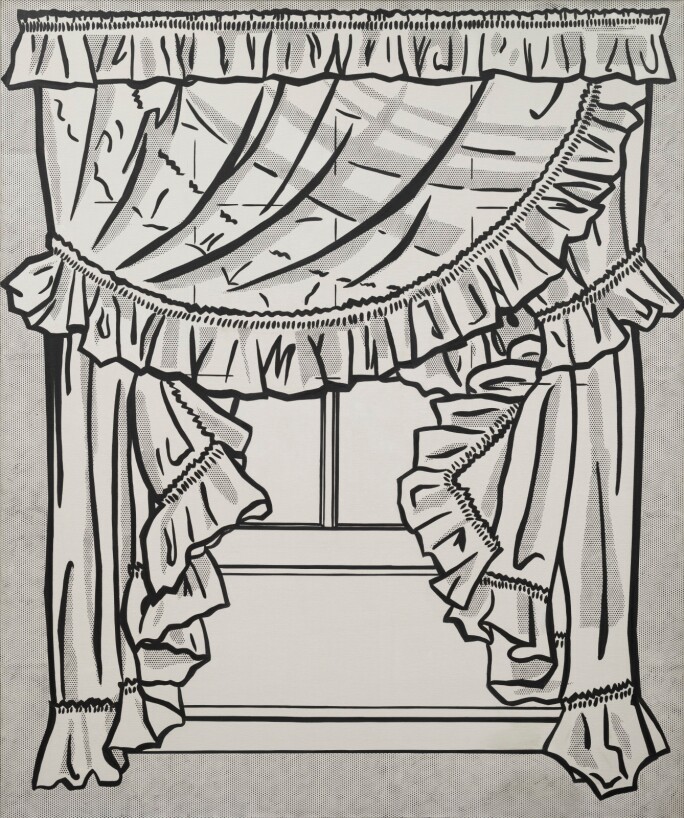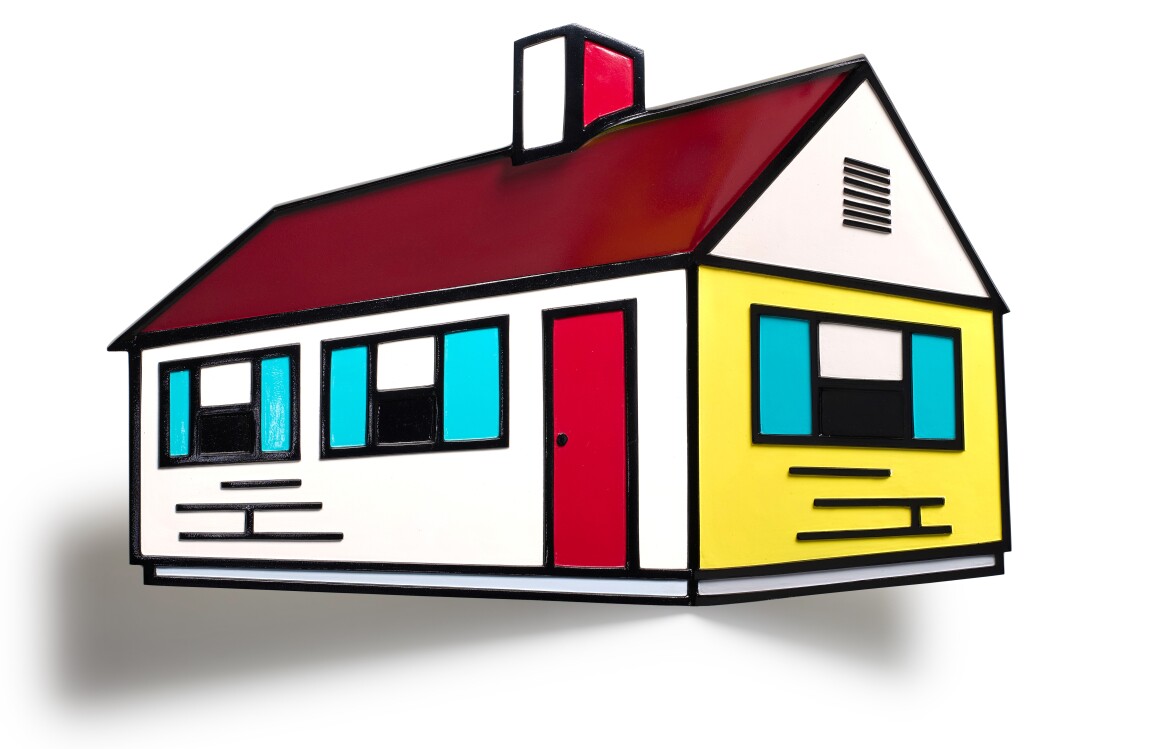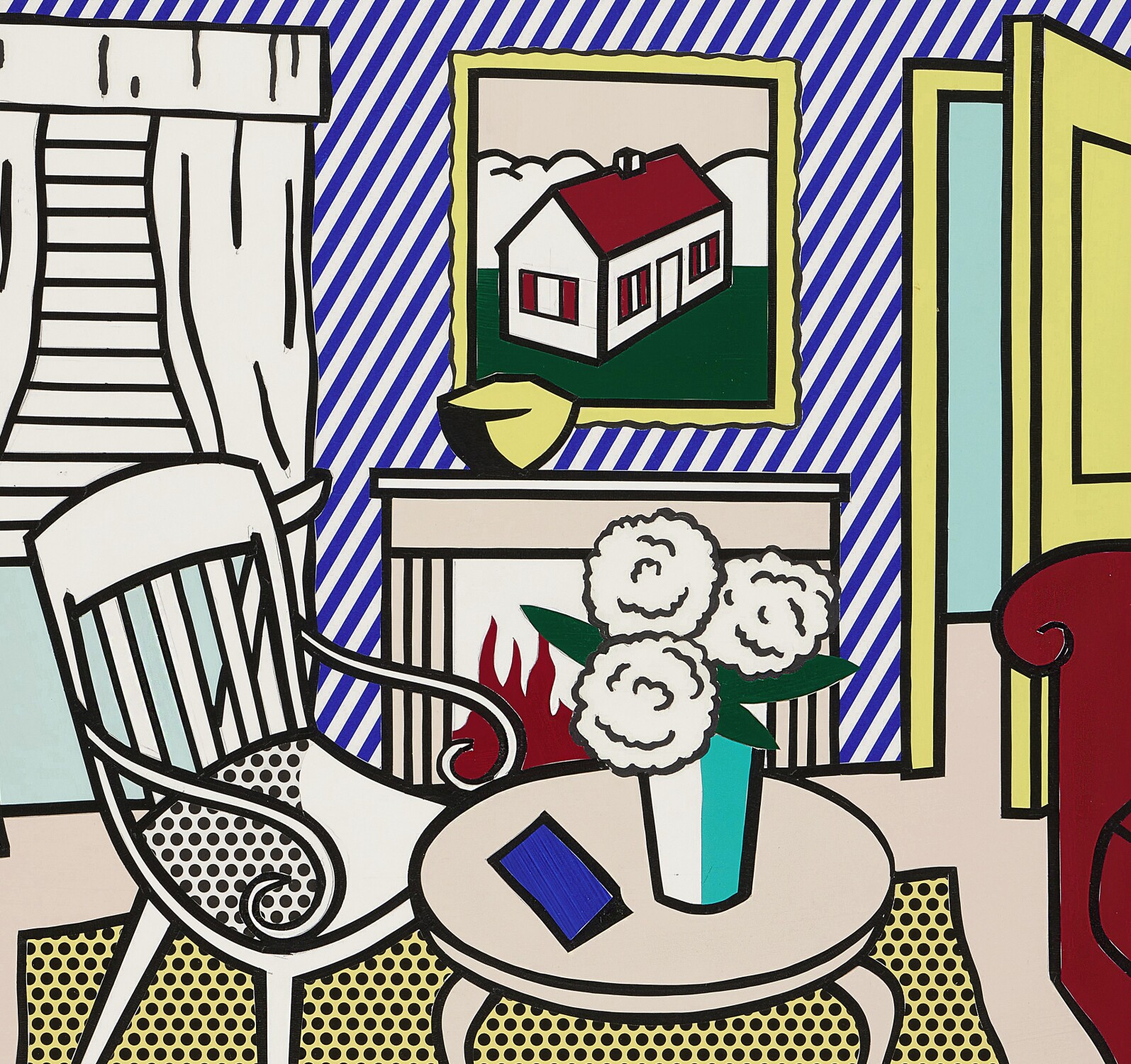
Interior with Painting of House (Study) from 1997 belongs to Roy Lichtenstein’s illustrious and highly acclaimed Interiors series, a late body of work that revisited the conceptual terrain that had shaped his practice since the early 1960s. In these works, Lichtenstein re-engages with the vocabulary of consumer culture – magazine layouts, catalogue pages, and aspirational advertising – while simultaneously reflecting on the nature of perception, illusion, and the mediated environments of modern life. Rendered in cut and painted paper, marker, and graphite, Lichtenstein’s studies are not merely preparatory sketches but fully resolved compositions that exemplify the artist’s lifelong investigations of illusionistic representational devices and his concern with the intersection of Modernist style and domestic desire. That large scale Interior paintings such as Interior with Mirrored Wall from 1991 are held in esteemed collections including the Guggenheim in New York, is a testament to the importance of this epochal series within the artist’s timeless oeuvre.

Right: Vilhelm Hammershoi, Interior, Strandgade 30, 1904, Musee d'Orsay, Paris, Image: © Bridgeman Images
"Within the interiors, Lichtenstein lampoons his own art as well as that of others. Yet his allusions and appropriations never mock or condescend. They provoke a wry smile, one perhaps similar to the gleeful expression in his eyes that accompanied the slightest beginnings of a wicked grin. More often than not, his humor was directed at himself. Many of his own works appear on the walls of the interiors, but are stylized – Lichtenstein's versions of Lichtenstein's."

Coming from the esteemed collection of Roy and Dorothy, the present work delineates a staged living room in the artist’s iconic graphic lexicon: flattened colour fields, bold black outlines, and the mechanical regularity of his Ben-Day dots. A crisp white chair, deep burgundy sofa, and angular patterned rug are arranged in geometric equilibrium, forming a stylised tableau that speaks more to artifice than habitation. Echoes of Henri Matisse’s decorative surfaces reverberate through the rug’s rhythmic geometry, while the spatial compression of the interior recalls the formal innovations of Fernand Léger’s Cubist compositions. Yet the most conceptually charged element lies on the far wall: a framed painting of a house, presented as a discrete artwork within the artwork. This internal picture is not a generic decorative element but a direct quotation from Lichtenstein’s own earlier series of house paintings, a deliberate act of self-reference that implicates the artist’s past oeuvre within the fictional space of the present scene. By inserting one of his own images into this highly mediated environment, Lichtenstein collapses the boundary between creator and constructed world, invoking the recursive logic of mise en abyme to destabilise the viewer’s sense of pictorial reality. The house painting becomes both a compositional anchor and a conceptual pivot, reinforcing the artificiality of the scene while simultaneously asserting the artist’s presence within it. In this way, Lichtenstein offers not simply a critique of bourgeois domestic aesthetics, but a reflexive meditation on the mechanisms of representation itself – how art inhabits space, circulates meaning, and ultimately constructs the visual language through which cultural identity is performed.

Though conceived as a study, the present work distills the intellectual and formal sophistication of Lichtenstein’s larger paintings. These collaged maquettes were an essential part of his working process, allowing him to manipulate compositional dynamics and visual rhythms with a precision that the final canvases would formalise. The medium of collage introduces a tactile contrast to the smooth, detached aesthetic for which Lichtenstein is best known. The hand-cut edges, visible seams, and layered textures offer a glimpse into the artist’s methodology, revealing the artifice beneath the surface of seamless design. In this way, the work retains a quiet materiality even as it performs the visual language of mass production. Interior with Painting of House (Study) should therefore be understood not merely as a formal exercise, but as a meditation on how images circulate, are consumed, and come to shape our cultural consciousness.

© Bridgeman Images 2025 Bridgeman Images
In its celebration of comfortable consumerism, Interior with Painting of House (Study) and other works within the series recall Richard Hamilton’s seminal collage of 1956, Just what is it that makes today’s homes so different, so appealing? Considered one of the earliest manifestations of Pop Art, Hamilton’s prophetic collage depicts an interior awash with the latest ‘must-have’ appliances for the ideal home and infused with the over-inflated desires and beauty stereotypes propagated by consumer culture. Lichtenstein’s late interiors present a similarly ‘idealised’ version of daily life in the modern home updated for the 1990s: the flashy, synthetic colour scheme sardonically perpetuates the excessive inflation of consumer dreams first acknowledged as part of the USA’s turbo-economy following World War II. Cassandra Lozano argues that this concept of the distillation of consumer culture reaches its apogee within this series:

Rather than reproducing reality, Lichtenstein’s stylised interiors critique its representations; uncovering the visual codes and underlying ideologies that define modern domestic life. Collapsing the distinction between high art and low image culture, and drawing attention to the semiotic systems through which space, value, and identity are constructed. Interior with Painting of House (Study) thus reflects Lichtenstein’s consummate ability to transform the ordinary into the iconic, the commercial into the conceptual. The room he constructs is not a room at all, but an image of a room, a surface designed to be seen, decoded, and desired. As such, it belongs not only to the visual economy of Pop but to a broader inquiry into how art can reveal, and indeed inhabit, the systems that shape contemporary life.